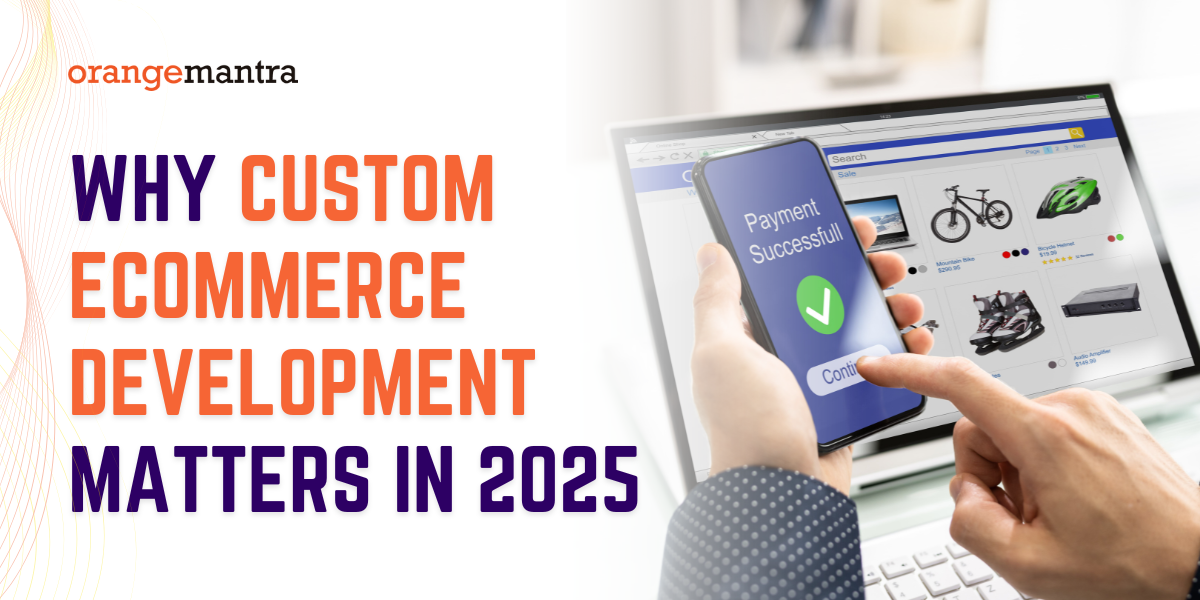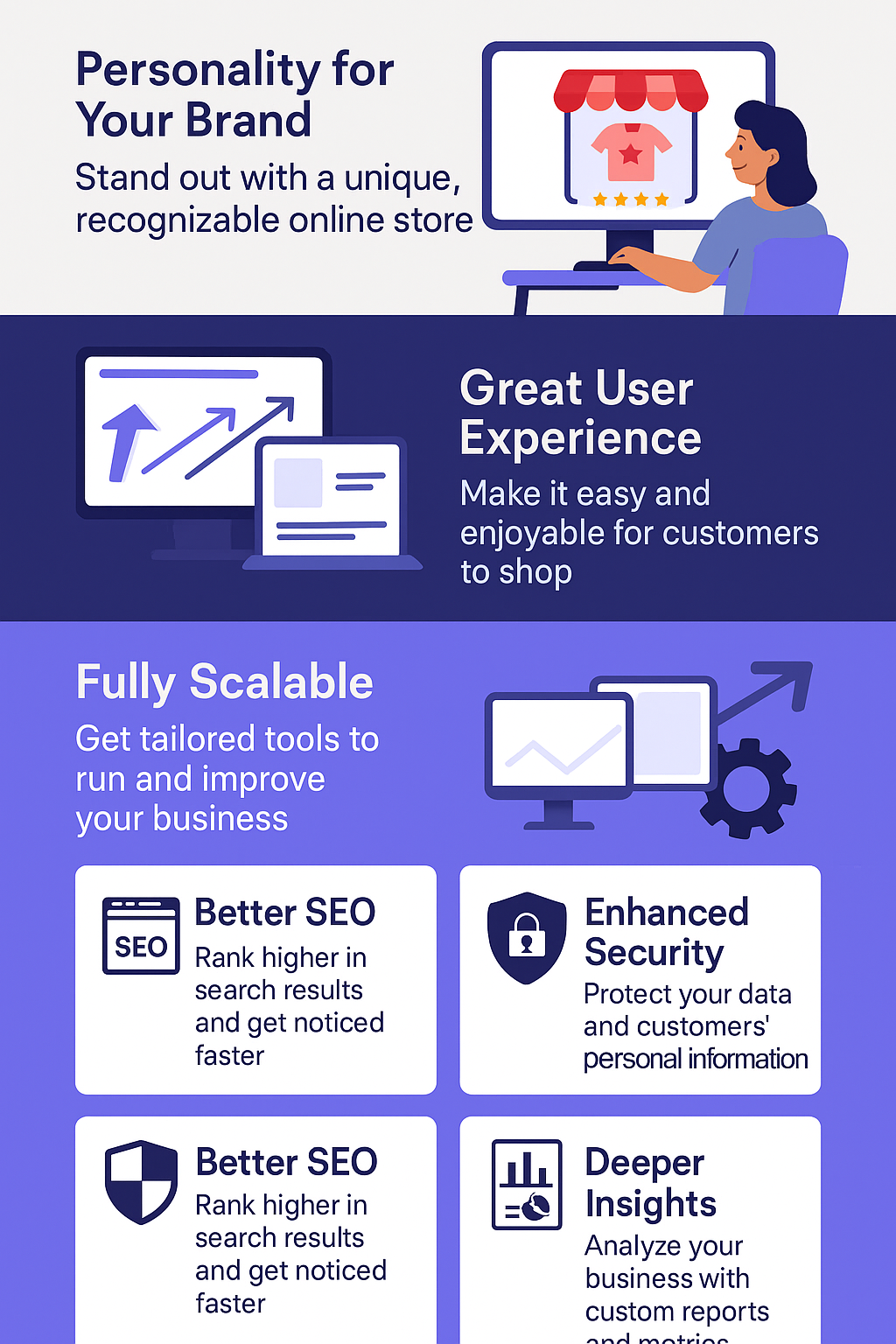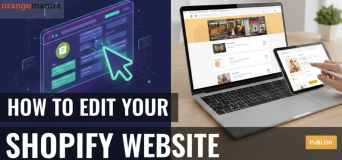
Here’s what you will learn:
Over 70% of online businesses lose potential sales because their websites don’t match what buyers expect.
Why? The experience isn’t smooth. Products are hard to find. The checkout takes too long. The design looks like hundreds of other stores.
This is exactly why Custom eCommerce Development has become essential for brands that want to win, retain, and grow their online audience.
If you’re still relying on generic platforms, you might already be falling behind.
In this blog, let’s explore why custom eCommerce development is a game-changer in 2025.
Table of Contents
What is Custom ECommerce Development?
Let’s keep it simple. Custom ECommerce Development means building your online store exactly the way you need it.
Instead of using templates or off-the-shelf solutions, you get something tailor-made for your brand, products, and customers.
It’s like building a house from scratch rather than renting a ready-made apartment. You choose the layout, design, features—everything.
Custom eCommerce development involves:
- Personalized design and branding
- Business-specific features
- Better performance
- Seamless integrations (with CRM, ERP, payment systems, etc.)
- Stronger security
Many businesses—small, mid-size, and large—work with a custom ecommerce solution company like OrangeMantra to make this happen. The goal is simple: create an online store that actually works for your business.
Why Not Use Templates?
Templates are fine—for beginners. But if you:
- Have specific business workflows
- Sell complex or customizable products
- Need integrations with back-end systems
- Want long-term flexibility
…then going custom is the better path.
Let’s say you run a store that sells personalized furniture. You need features like room previews, custom size options, or dynamic shipping calculations. Can a template do all that? Not easily.
Must-Have Features of a Custom eCommerce Solutions
A great online store does more than just show products. It makes shopping easy, fun, and safe. When you use Custom eCommerce web design services, here are the must-have features you should include:
For Shoppers (Front-end Features)
These features help your customers browse, choose, and buy without any confusion.
Clear product pages
Show big pictures, short descriptions, prices, and options like size or color.
Easy search bar
Let people type what they want and find it fast.
Product filters
Help them narrow results by price, brand, size, or other options.
Shopping cart
Let users add products and review them before buying.
Wish list
Allow shoppers to save items for later.
Mobile-friendly design
The website should work well on phones and tablets.
Quick and secure checkout
Keep the steps short and easy. Offer safe payment options like cards, wallets, or UPI.
Order tracking
Let customers see where their order is and when it will arrive.
For Store Owners (Back-end Features)
These tools help you run your store without stress.
Product management
Add, edit, or remove products anytime.
Inventory tracking
See how many items are in stock. Get alerts when something runs low.
Discount and coupon settings
Create special offers, sales, or discount codes.
Order management
Check new orders, update statuses, and handle returns.
User management
View customer profiles, order history, and support requests.
Dashboard with reports
See daily sales, top products, and traffic in one place.
SEO-friendly tools
Let your pages show up better in search results. Simple things like clean URLs and title tags help.
Extra but Useful Features
You can also add smart features based on what your store needs.
Live chat or chatbot
Help shoppers quickly if they have questions.
Reviews and ratings
Let buyers leave honest feedback on products.
Multi-language and currency
Sell across different countries and make users feel at home.
Personalized suggestions
Show items based on what someone looked at before.
Social sharing buttons
Let users share your products with their friends.
When you work with a good custom eCommerce development company, they’ll help you pick the right mix of features. Not every store needs everything. But every store should make shopping smooth and simple.
The more helpful your website is, the more likely people are to come back and buy again.
Business Benefits of Going Custom Web
Choosing a custom eCommerce web development means you get exactly what your business needs. You don’t have to settle for what a ready-made template gives you.
Here’s how going custom can help your business grow:
Your Brand Looks Unique
You get a design made just for you. No one else will have the same look. It shows your brand’s true style and values.
Better Shopping Experience
The site works the way your buyers expect. It’s easy to browse, click, and buy.
Fewer steps = more sales.
Grows With Your Business
Add new features when you need them. Sell more products, enter new markets, or expand services—without starting over.
Faster Website, Happier Customers
A custom-built site can load quicker. People don’t like waiting, especially online. A fast site keeps them on the page longer.
Easier to Manage
You get tools that match your business tasks. Manage products, check orders, and track sales easily.
Safe and Secure
Custom sites can follow strong security steps. Keep your customer data safe and your site protected from hackers.
Works Well with Your Other Tools
Want to connect your store to a CRM, ERP, or payment gateway? custom ecommerce web development makes that simple.
Helps You Rank Better on Google
Clean code and smart layout help with SEO. That means more people can find your store in search results.
No Extra Fees
You own your site. You won’t pay monthly platform charges or deal with unwanted updates.
At OrangeMantra, we’ve seen how custom eCommerce solutions make a real difference. We help brands not just launch a store—but build one that works better, runs smoother, and grows with time.
If you’re serious about building an online store that lasts, going custom is the smart move.
Custom eCommerce Web Development Process
Building a custom eCommerce website takes time. It doesn’t happen overnight, but each step is important.
Here’s how the process usually works:
Understanding Your Business
The first step is to talk. You share what your business does and what you need. The team learns about your products, your customers, and your goals.
Planning the Project
A list of must-have features is made. This can include things like search filters, payment options, and user accounts. The tech team picks the best tools and layout for your store.
Design Time
Designers create how your website will look. Colors, buttons, and layout are all planned carefully. You get to see and give feedback before the building starts.
Building the Website
Now the developers write the code. This is where the site actually comes to life. Frontend (what users see) and backend (the engine behind it) are both built here.
Testing Everything
Once the website is built, it’s tested. The team checks for bugs, errors, or slow pages. They make sure it works well on both computers and phones.
Launching Your Store
When all is ready, the site goes live. Your store is now open to shoppers. The team watches closely for the first few days to fix any surprises.
Support and Updates
After launch, updates are still important. You might want to add features or fix small issues. A good development partner sticks around to help.
At OrangeMantra, we follow this simple and clear process to build custom eCommerce websites. We work step by step—so nothing is rushed and everything fits your needs.
A smart process leads to a better store—and a better result for your business.
Cost of Custom eCommerce Web Services in 2025
Custom eCommerce web Services are an investment. It costs more than using a ready-made template, but you get more in return.
Here’s a simple breakdown to help you understand where your money goes and why.
How Much Does It Cost?
The price can change depending on how big your store is and what features you want. Here’s a rough estimate based on multiple sources:
| Type of Store | Estimated Cost (USD) |
| Small store (basic features) | $2,000 – $5,000 |
| Medium store (with add-ons) | $5,000 – $15,000 |
| Big store (with custom tools) | $15,000 – $40,000+ |
| Enterprise marketplace platform | $5,000 – $90,000+ |
These are rough numbers based on 2025 trends.
What Affects the Cost?
Features
More features = more time = higher cost.
Example: filters, tracking, payment gateways, AI suggestions.
Design complexity
A simple layout costs less than a fully custom design.
Integrations
Want to connect with your CRM or shipping partner? That adds to the price.
Mobile app
If you want an app too, the cost goes up.
Where your team is based
Developers in the US cost more than teams in India or Eastern Europe.
One-Time vs Ongoing Costs
You’ll pay once for design and development. But you may also have monthly costs like:
- Hosting
- Maintenance
- Security updates
- New features
At OrangeMantra, we always suggest setting a budget for post-launch support. A good eCommerce site is never “done”—you keep improving it over time.
Is It Worth It?
Yes—if you’re serious about selling online. While the cost may seem high at first, a custom eCommerce development project:
- Brings in more traffic
- Converts more visitors into buyers
- Saves money in the long run (no extra fees or plug-in overload)
It’s not just a website. It’s your online business.
Development Timeline
Custom eCommerce web development takes time. It’s not done in a weekend—but it’s worth the wait. The time depends on how big the store is and how many features you want.
Here’s a rough idea of how long it may take:
| Type of Store | Time Needed |
| Small store (basic features) | 6 to 8 weeks |
| Medium store (with more tools) | 10 to 16 weeks |
| Big store (with custom functions) | 4 to 6 months |
| Enterprise-level platform | 6 months to 1 year |
What Can Slow It Down?
- Too many change requests during the project
- Complex features like AI search or advanced filters
- Waiting on feedback or approvals
- Adding mobile apps along the way
At OrangeMantra, we guide clients through each step so there are no surprises. A good timeline keeps everyone on track and avoids delays.
Tip: Plan early and leave a little buffer time. Good things take time—and a well-built store lasts for years.
What Makes a Good Custom eCommerce Development Company?
Here’s what you should look for:
- Experience in your industry
- Strong design and UX capabilities
- Post-launch support and scalability planning
- SEO knowledge
- Transparent pricing and communication
- Portfolio of successful eCommerce site development projects
Whether you go with OrangeMantra or someone else, make sure they understand both tech and business. Because you’re not just building a site—you’re building a revenue engine.
When Should You Go for Custom eCommerce Solutions?
- You’ve outgrown your current platform
- You need special features or integrations
- You want complete design freedom
- You need better performance and speed
- You want to improve your SEO or mobile experience
- You’re expanding your product line or geography
- You care about long-term ROI
If any of these sound like your business, it’s probably time to explore a custom solution.
eCommerce Development Solution: Template vs Custom
| Aspect | Template Site | Custom Development |
| Cost | Lower upfront | Higher upfront, better ROI |
| Speed to Launch | Fast (2-4 weeks) | Slower (6+ weeks) |
| Design | Limited, generic | Fully tailored |
| Features | Limited to plugins | As per business needs |
| Scalability | Often Limited | Built to scale |
| SEO & Speed | Average | Highly optimized |
| Ownership | Platform-owned (mostly) | Fully owned by you |
Quick Tips Before You Start
- Always start with a strategy. Don’t jump into design or features.
- Talk to your team—sales, support, ops. They’ll tell you what the store really needs.
- Pick performance over flashy. Fast, clean stores win.
- Choose mobile-first design. Over 78% of eCommerce traffic is mobile.
- Ask for post-launch support. You’ll need it.
Conclusion
Building a custom eCommerce website may take more time and money—but it gives you more in return.
You get a store that:
- Looks like your brand
- Works the way you need
- Grows as your business grows
- Keeps your customers happy
If you’re serious about online selling, going custom is the smart move.
At OrangeMantra, we’ve helped many brands build online stores from the ground up. Whether you’re just starting or ready to level up, we’re here to help you figure out what works best for your business.
You don’t need to follow the crowd. You just need a store that fits you.
FAQs
Q1. What are the 4 types of customizations?
There are four main areas where your ecommerce store can be customized:
- Design customization – You can change how your website looks. This includes layout, colors, fonts, buttons, and page structure. It helps your store match your brand.
- Feature customization – You can pick what features your store should have. For example, live chat, smart filters, wishlist, or quick buy buttons.
- System integration – You can connect your website with tools you already use. This can include CRMs, payment apps, inventory software, or shipping systems.
- User experience customization – You can improve how users move around your store. This includes fast loading, easy search, clean mobile view, and fewer checkout steps.
Q2. What is customization in development?
Customization in development means building something that works just the way you want. Instead of using a ready-made setup, you get to choose how your website looks and works. This way, the site fits your business and your users better.
Q3. How do I know if custom ecommerce development is right for my business?
Custom ecommerce is a good fit if:
- You don’t want your site to look like everyone else’s
- You have a special product or service that needs custom features
- You plan to grow or scale in the future
- You want full control over the store
- You need to connect your site with other tools like accounting, CRM, or delivery apps
If you answered “yes” to even a few of these, going custom may be the better choice.
Q4. What features can I expect from a custom ecommerce platform in 2025?
Custom ecommerce websites in 2025 can offer:
- Fast loading pages and clean design
- Smart product search and filters
- Personalized suggestions for shoppers
- Easy checkouts with multiple payment options
- Mobile-first experience for phones and tablets
- Real-time order tracking
- Integration with apps you use for marketing, delivery, or customer service
- Strong security to protect user data
You only add what your store needs. Nothing more, nothing less.
Q5. Can I manage my custom ecommerce store without technical expertise?
Yes, you can. Your development team can build a simple dashboard that lets you:
- Add or remove products
- Change prices and pictures
- Create discount codes
- See orders and track deliveries
- Post blogs or content updates
You don’t need to know how to code. If you can use a computer or phone, you can manage your store.
Q6. Do you provide custom ecommerce development for both B2B and B2C businesses?
Yes, we work with both.
- B2B (Business to Business): Stores that sell to other companies. These often need bulk pricing, order forms, account logins, or special approvals.
- B2C (Business to Customer): Stores that sell directly to regular people. These focus more on product experience, checkout, and marketing.
At OrangeMantra, we understand both models and build what fits each one best.
Q7. Why is custom ecommerce software development the future of online retail?
Online shopping is changing fast. People want websites that are quick, easy, and personal. Businesses want tools that fit their work, not the other way around.
Custom ecommerce lets you:
- Keep up with new trends
- Offer better shopping experiences
- Add new features anytime
- Stand out from the crowd
- Grow without limits
That’s why more brands are choosing custom over ready-made setups.
Q8. Can I integrate third-party tools or software into my custom ecommerce platform?
Yes, you can. Your website can connect with:
- Payment apps like PayPal, Razorpay, or Stripe
- CRMs to manage leads and customer details
- Delivery and shipping partners
- Email tools for marketing
- Accounting software for billing
Custom development makes it easy to add these tools. You choose what you need, and the tech team connects everything for you.



